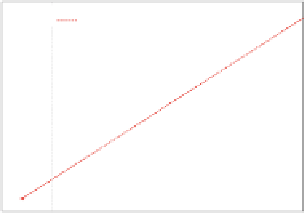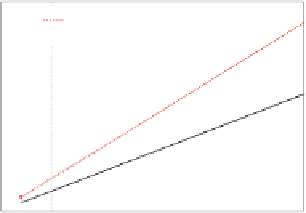Information Technology Reference
In-Depth Information
Energy Components Comparison (Terf 3x3)
Total Energy Comparison
180000
300000
Magnets
Capacitance
Terf 3x3
Terf 5x3
Ni 3x3
Ni 5x3
160000
250000
140000
120000
200000
100000
150000
80000
60000
100000
40000
50000
20000
0
0
0
100
200
300
400
500
600
0
100
200
300
400
500
600
PZT thickness (nm)
PZT thickness (nm)
(a)
(b)
Fig. 16.
(a) Comparison between energy consumption components for a 3
×
3
NAND/NOR with magnet of Terfenol. Energy required to reset the magnets is con-
stant and much lower than energy lost to charge the capacitor. (b) Comparison between
NAND/NOR with different sizes and different materials. Nickel has an overall lower
energy consumption due to a higher Young modulus.
against 1400
Kb
T
with a PZT thickness of 40 nm). To be fair also the losses due
to Joule effect should be considered, however, since piezoelectric materials are
insulators, the value of current is so small that the resulting losses are 7-8 orders
of magnitude smaller than the energy required to charge the capacitance, that is
the only really important source of energy loss. Moreover, the distance between
electrodes is quite big so no relevant tunnel current can be expected.
Figure
16
(b) shows instead a comparison between the total energy consump-
tion with gates of different sizes, 3
5 (that means an height of 3
magnets and a width of 5 magnets), and considering both terfenol and nickel
as magnetic materials. As can be clearly observed gates with a width of 5 mag-
nets have a bigger energy consumption than gates with a width of 3 magnets.
This is expected because with a bigger width the capacitance is smaller while
the voltage is bigger. From Eq.
14
it is evident that voltage has a bigger impact
compared to the capacitance, so reducing the capacitance and increasing the
voltage overall increases the energy consumption. What is partially unexpected
is that, changing the magnetic material employed changes the total energy con-
sumption. As can be seen from Fig.
16
(b), using Nickel leads to a lower energy
consumption. This can be explained looking at Eq.
13
. Nickel magnets require
a bigger stress, nonetheless their Young modulus is also bigger, so overall the
required voltage and the energy consumption are lower. While Nickel shows a
reduced power consumption, Terfenol remains the privileged choice for its better
tolerance to process variations.
PZT thickness is an important parameter that must be chosen carefully
considering both energy consumption requirements and technology limitations.
With magnets 10 nm thick the minimum thickness for the PZT substrate is
40 nm. The PZT must be much thicker than the magnets to be sure that the
mechanical stress is completely transferred from the substrate to the magnets.
×
3 and 3
×
















































































































































































































































Search WWH ::

Custom Search